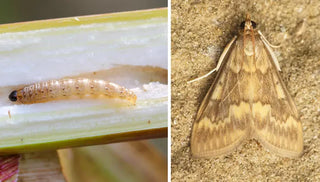Shot hole damage on corn leaves is a telltale sign of European corn borers. These beige caterpillars also bore into the main stalk of corn plants, leaving behind holes filled with what looks like sawdust. Their feeding clogs the movement of water and nutrients to the leaves and weakens the stalks, often causing them to break. Corn borers also bore into stems and pods of beans, tomatoes, potatoes, peppers and other crops. The borers overwinter in old cornstalks and plant debris, pupating in early spring.
The adult form, a tan-colored moth, emerges in late spring and deposits cluster of white eggs on the undersides of leaves. There are usually several generations each year. The European corn borer is a common pest throughout the northern and eastern U.S. Its range extends west as far as Montana and south to Arkansas.
Prevention and Control
- Plant corn varieties that are resistant to corn borers.
- Once corn silks wilt and begin to turn brown, use a medicine dropper to squirt a small amount of vegetable oil into the tip of each ear of corn. Do not do this before the silks begin to brown as it may interfere with pollination.
- At the end of the growing season, remove and shred old corn stalks to kill larvae that might otherwise overwinter.




